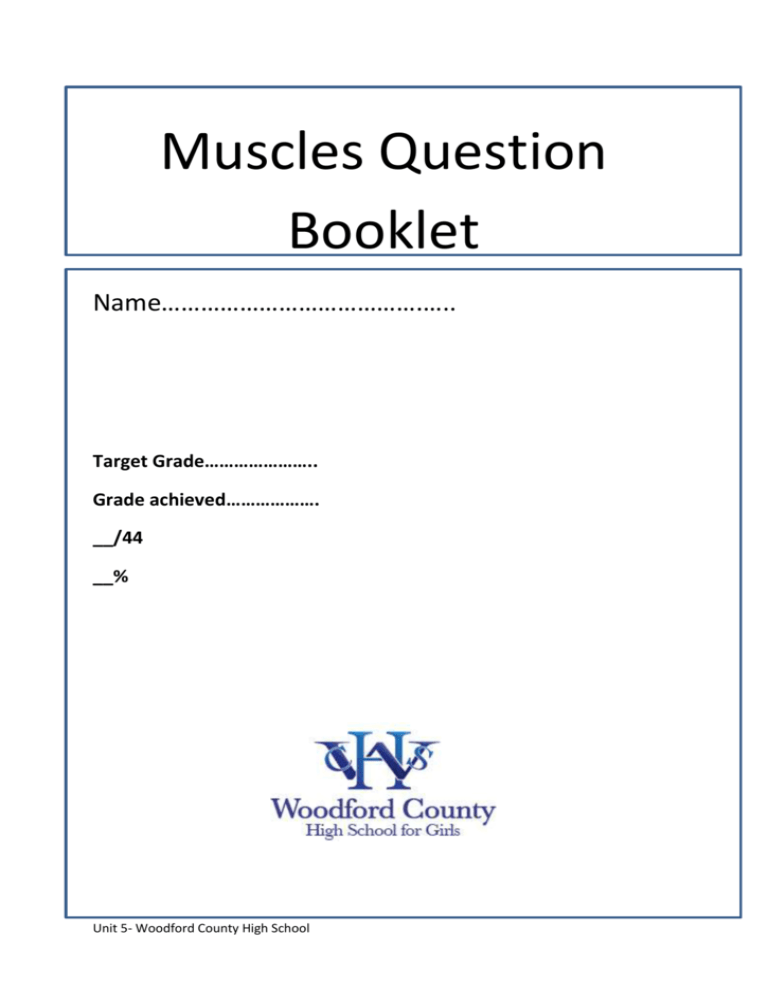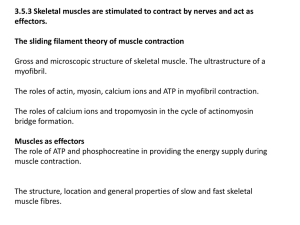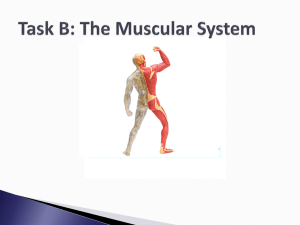Muscles - WordPress.com
advertisement

Muscles Question Booklet Name………………………………….….. Target Grade………………….. Grade achieved………………. __/44 __% Unit 5- Woodford County High School Question 1 Unit 5- Woodford County High School Unit 5- Woodford County High School Question 2 Unit 5- Woodford County High School Question 3 Unit 5- Woodford County High School Question 4. (a) What is the role of phosphocreatine in providing energy for muscle contraction? ..................................................................................................................................... ..................................................................................................................................... (1) Unit 5- Woodford County High School (b) The table shows some differences between slow and fast muscle fibres. Slow muscle fibres Fast muscle fibres Enable sustained muscle contraction to take place Allow immediate, rapid muscle contractions to take place Many mitochondria present Few mitochondria present Depend mainly on aerobic respiration for the production of ATP Depend mainly on glycolysis for the production of ATP Small amounts of glycogen present Large amounts of glycogen present (i) Explain the advantage of having large amounts of glycogen in fast muscle fibres. .......................................................................................................................... .......................................................................................................................... .......................................................................................................................... (2) (ii) Slow muscle fibres have capillaries in close contact. Explain the advantage of this arrangement. .......................................................................................................................... .......................................................................................................................... .......................................................................................................................... .......................................................................................................................... (2) (Total 5 marks) Question 5 The diagram shows part of a myofibril from a relaxed muscle fibre. Z line A band I band H zone 1.0 m Unit 5- Woodford County High School (a) When the muscle fibre contracts, which of the A band, I band and H zone (i) remain unchanged in length, .................................................................................... (1) (ii) decrease in length? ................................................................................................... (1) (b) Explain what caused the decrease in length in part (a)(ii). ..................................................................................................................................... ..................................................................................................................................... ..................................................................................................................................... (2) (c) The whole muscle fibre is 30 mm long when relaxed. Each sarcomere is 2.25 µm long when contracted. Use the scale given on the diagram to calculate the length of the contracted muscle fibre in millimetres. Length of contracted fibre = ...................................... mm (2) (d) The table gives some properties of the two different types of muscle fibre found in skeletal muscle. (i) Complete the table by writing the words ‘high’ or ‘low’ for the remaining three properties of each type of muscle fibre. Type of muscle fibre Type 1 Type 2 Speed of contraction high low Force generated high low Activity of the enzymes of glycolysis high low Number of mitochondria Activity of Krebs cycle enzymes Rate of fatigue (3) Unit 5- Woodford County High School (ii) The myosin-ATPase of type 1 muscle fibres has a faster rate of reaction than that in type 2 fibres. Use your knowledge of the mechanism of muscle contraction to explain how this will help type 1 muscle fibres to contract faster than type 2. ......................................................................................................................... ....................................................................................................................... .......................................................................................................................... (4) (iii) The blood leaving an active muscle with a high percentage of type 1 muscle fibres contained a higher concentration of lactate than that leaving a muscle with a high percentage of type 2 muscle fibres. Explain why. .......................................................................................................................... .......................................................................................................................... (2) (Total 15 marks) Unit 5- Woodford County High School Mark Scheme Question 1 Question 2 Unit 5- Woodford County High School Question 3 Unit 5- Woodford County High School Question 4. (a) Produces ATP; A correct equation (b) (i) (ii) R energy store 1 Anaerobic respiration / glycolysis inefficient / produces little ATP; requires large amount of glucose to produce enough ATP; glycogen acting as glucose store / glycogen converted to glucose; R source of energy/ energy store max 2 Requires oxygen / glucose; short diffusion pathway / rapid passage of oxygen; Removal of heat/CO2; max 2 [5] Question 5 (a) (i) A band; (ii) (b) (c) 1 H zone and I band; 1 filaments in I / thin filaments / actin filaments slide in between myosin / thick filament; thin filaments enter H zone / meet in middle of A band / pull Z lines closer; correct answer: 22.5 mm ;; Unit 5- Woodford County High School = 2 marks 2 OR relaxed sarcomere length = (d) (i) 48 / = 3 m ; 16 = 1 mark In table: low high low high high low (1 mark per row;;;) (ii) 2 max 1. overall rate of contraction limited by rate of ATP-splitting; 2. ATPase splits ATP / hydrolyses ATP / converts ATP to ADP (+ phosphate); 3. ATP-splitting provides energy for any TWO from myosin-actin interaction;myosin head movement / actin to move relative to myosin; to ‘cock’ myosin head; 3 4 max (iii) lactate = product of anaerobic respiration; type 1 has higher activity of glycolytic enzymes / has lower activity of Krebs cycle enzymes / has fewer mitochondria; 2 [15] Unit 5- Woodford County High School









